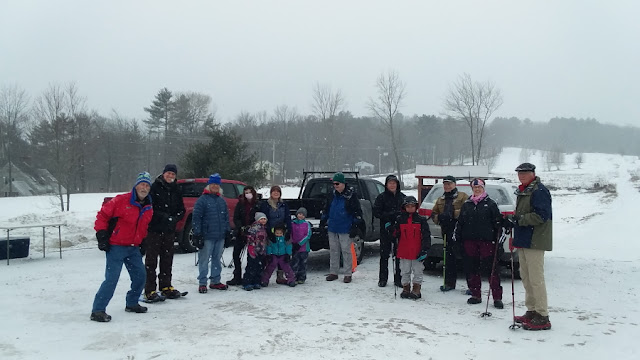Winter returned this week - after a brief glimpse of Spring on Monday when the temperatures rose to the mid 50s, climbing up to 58 on our thermometer. So that was the day I took a hike up Cannon Mountain in Franconia Notch, and while it was a beautiful day, sunny and calm, it still certainly looked like winter above 3500'.
 |
| Kinsman Ridge Trail on Cannon Mountain. |
Even in that harsh environment there are a few hardy critters that eke out a living high above the notch. I found lots of tracks of snowshoe hares all along, even in the trail.
 |
| Snowshoe Hare tracks dotted the landscape above 3700'. |
The snowshoe hare is a wonderfully adapted animal with large hind feet which let it hop along the snow giving it an advantage in escaping its pursuers which include fox, coyote, bobcat, and lynx. (I did see predator tracks near the hare tracks but I couldn't identify them.) These hares also have fur on the bottom of their feet to protect them from the cold. In the winter they sustain themselves by eating bark and twigs of trees. Another valuable trait, shared by other hares and rabbits, is having multiple litters per year, producing lots of offspring which balances their high attrition rate. Snowshoe hares are nocturnal, giving them an additional level of protection, though owls, another significant predator of hares, have also adapted to hunting in low light. And then there's the hare's heavy fur which changes color twice a year: white fur in the winter, mottled brown in the summer, both to blend in with their surroundings.
For all these reasons, I've never seen a snowshoe hare itself but have seen their tracks in many places, often near the summits of mountains including Cannon, Welch, Roberts, Whiteface, and Morgan. But they are present at lower elevations too, including around the lakes. I've seen their tracks in the Hamlin Forest on the Red and White Trails as well as right near downtown Meredith in Community Forest.
 |
| Recent snowshoe hare tracks in Hamlin, February 5th. |
I also saw two bird species high up on the summit of Cannon: Common Redpolls, and a single Pine Grossbeak. I heard the redpolls before I saw them, just below the summit at an elevation of 3850'. I stopped to see what was chattering and soon saw a few redpolls in the stunted spruce trees. Then another group flew in. Then another dozen or so, starting to make quite a racket. They all took off together and circled around over me, and then another group joined in, and then another, and another joined the swirling flock, until there were at least 50 of them flying in ragged circles just above the tree tops before the entire flock spun off out of sight. I'm confident in my estimate of well over 50 based on my recent counting of goldfinches in the trees around our birdfeeders. I've counted up to 30, and when they took off, their flock was considerably smaller than this gang of redpolls.
 |
| Just a portion of our goldfinch flock, about 20 right there. Many more were perched in the branches of the oak trees. (Plus one dark-eyed junco waiting its turn on the feeder.) |
The single Pine Grossbeak I saw was even closer to the summit of the mountain, and acting so nonchalantly beside the trail that I first thought it was a Canada Jay looking for a handout. (Canada Jays are so bold they will come to land on your hand if you offer it with some trail mix.) But when I got a better look - and listen - I determined it was a pine grossbeak. I only had my phone with me, so this is the best picture I got (and no pictures of the fast moving redpolls).
 |
| A pine grossbeak at 4000' on the summit of Cannon Mountain. |
It didn't have the rose or yellow coloring I would expect (leading me to the initial jay thought) but their coloration is quite variable and its distinctive song told me it was a grossbeak. I was also in the right habitat: subalpine spruce-fir forest.
We also had a different finch at our feeder this week, a house finch, our first of the year, but again, no pictures for you - it was here and gone in a minute. I have Linda's quick eye to thank for catching it.
On Superbowl Sunday I mentioned that owls were starting to mate, and the woodpeckers aren't far behind. I heard the back and forth rat-a-rat of two downy woodpeckers staking out their mating territory in the woods last week. One would bang away on a hard, dead, resonant snag to let all know he has claimed that piece of the woods, and as as soon as it stopped another bird far away answered back with its reply from his home turf. As long as the two birds keep their distance and each hears only a faint hammering, all will be well. But if one moves in too close to the other, there will be trouble.
 |
| This downy woodpecker must be looking for food - I think he knows this is too small for a nest! |
With eight inches of sparkling light snow on Friday, winter is back. It's hard to remember that on Monday was 50 degrees with the streams flowing like spring.
 |
| Spring melt runs into the Mill Brook on February 18th. |
 |
| February 26th. Photo by Linda Powell. |
Scenery sure changes rapidly in a New Hampshire winter.



















































